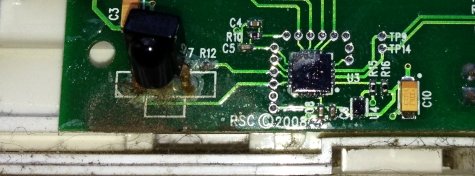The FrequencyCast cat was unexpectedly grounded this week due to a circuit failure in his feline ingress / egress portal.
Cat Flap Fail
To prevent alien cats from entering the house, the FrequencyCat’s owner installed a high-tech locking catflap that only allows cats with a coded infrared chip on their collar to trigger the unlocking process, and this has worked very well for some time – although when we were testing the Loc8tor Cat Tracker (pictured here) some while back, his collar did resemble a Swiss Army Knife.
This week, we heard one very unhappy moggy head-butting a locked cat flap as the mechanism was refusing entry. He had the right collar, password, and everything.
As a good techhie, Pete tested the batteries in the infrared collar key, as well as the batteries in the catflap controller – voltage was slightly low, so the batteries were changes anyway. No joy.
Flap Fail
The catflap in question is a Staywell 500 Series Fifth Edition Infrared model, and after reading the manual, we decided that a call to Staywell’s UK Customer Help Line was in order. The listed number for Reilor Ltd (0808 144 4554) was no longer active, but Staywell’s UK website (operated by Petsafe Ltd) yielded the UK Customer Services number of 0800 046 14 14.
The young lady that answered the phone very promptly, was very helpful. As soon as we explained the problem, three flashing greed LEDs, followed by a red LED and a click – she’d identified the problem – a faulty control board. She helpfully explained how to disable the locking spring to allow the catflap to unlock and work as an unprotected catflap, but a new catflap was needed. Retail price, £65.
Fortunately, unlike many products, the Staywell catflaps come with a three year warranty, not just a single year. Unfortunately for us, ours ran out a few months ago, meaning no chance of a replacement.
Our Pete was just about to launch into “consumer rights” mode – as we feel it’s reasonable to assume that a catflap will last more than three years, but the young lady kindly offered to supply a replacement controller “at cost” (less than half the price of a new unit). The ordered replacement turned up from a company called Radio Systems Petsafe Europe two days later, and was in fact an entire replacement catflap, not just the faulty controller – which was a bonus.
We’ve also discovered, through our contact with Staywell’s site, that they have a new product – a catflap that’s triggered by the embedded microchip often installed by vets to help ID missing moggies. Check out the Petsafe Microchip Petporte Smart Flap (Petsafe, if you’re reading, fancy a review?)
So, full marks to Petsafe for helping out an out-of-warranty customer, but it’s sparked some discussion about “planned obsolescence” here at the office.
Planned Obsolescence
If you’re not familiar with this term, it’s the concept that it’s in the manufacturer’s interests to try to ensure that products need replacing. Some of the more common examples include:
- Can openers made of cheap material so they will break after a number of uses
- Companies selling video recorders whilst making DVD recorders
- Computer programs that require faster computers to run
- “End of life” – Withdrawing technical support on a product to force an upgrade (Windows XP)
- Water filters and toothbrushes that alert you to replace them
- Companies that hold back features to encourage a loyalty upgrade – Cough. Apple. Cough
The best example though, is the humble filament lightbulb. If you get the chance, watch the film “Pyramids of Waste: The Lightbulb Conspiracy” – Otherwise, have a quick read of The Lightbulb Conspiracy. The story goes that the life of the lightbulb was significantly reduced to ensure that us consumers kept having to replace them. Fascinating, and this is something we’ll be discussing in an upcoming show.

In the case of the catflap, we’ve no reason to suspect the 3.33 year failure was an example of this, and there’s no tell-tale “auto expire” chip on the faulty flap’s motherboard. There are signs of corrosion on some of the components on the board – consensus here being that wet cat moisture has settled over time on the legs of the components, which appear not to be protected by a housing.
Any examples, listeners?
If you’ve got any examples of products that have failed just outside of warranty, or that you think may have a concealed “expire outside guarantee”… please add a comment below, or Tweet @frequencycast and we’ll see if you’re interested in a feature